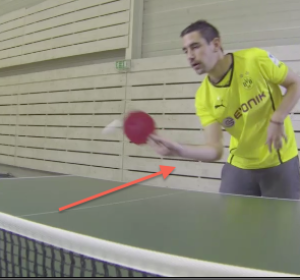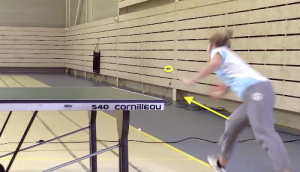Combining forehand and backhand by spreading yourself out over the space you cover
The area you need to defend may appear small and difficult to hit accurately for your opponent. However, defending your court is not easy. Covering all the space will require you to coordinate your forehand space and your backhand space. Areas of weakness will appear:
the crossover,
the side edges,
Covering the forehand and backhand will therefore be important for these students. They will do it in their own ways in the following videos.
The crossover is the space between the forehand and the backhand, as illustrated in the photo opposite. |
Video 1:
This video shows a student who combines his strokes.
We can see here that he covers his space by adapting the position of his upper body without moving and mobilising his legs. This will be a valuable strategy if the rhythm of play is not too fast and does not permit a lot of stroke diversity.
Video 2:
Here we can see a different adjustment.
This student adjusts her position by moving, with a burst of movement between strokes.
Advice from the coach:
This is a coordination between both movement and choice of stroke (sending the forehand or backhand to the side), which you need to start doing and integrating into your game in order to keep the match alive and compete for the point.
Video 3:
This player moves by jumping.
This student expends a lot of energy and only adjusts his position in “squats” (pushing up from the legs). This prevents him from sending the ball over with any speed.
Video 4:
This player covers both forehand and backhand spaces well.
In this video, this player manages to coordinate his movement and strokes by covering with the forehand and pushing with the backhand.
Advice from the coach:
We have observed a number of different problems relating to the combination of the two spaces, and also to movement coordination (mobility) and action on the ball:
students must simultaneously locate the points of contact with the trajectory and move to get the right distance from the ball. The sides and crossover spaces force you to move, either with the arm or by moving slightly and choosing the most opportune stroke (forehand or backhand),
the availability of your legs (slightly bent and balanced) give you improved reactions and let you get your
distance more easily,
the association of the right-forehand and left-backhand spaces enable you to cover these spaces for better
defence,
you can also see the difference in terms of the dissociation between the striking racket hand and the
opposite balancing hand.
Finding the area where the type of stroke changes (from forehand to backhand) depends on the person and will determine how well the player uses the sides.
EXERCISES
Here, the objective is to combine an instinctive wide return to the side (right, left) with the space to be defended (forehand and backhand).
Exercise 1:
Offer up 2 trajectories, including one down the centre, with the freedom to position yourself wherever you want.
Exercise 2:
Send over 3 balls (by hand from the basket or using a racket, in threes or continuously), with 2 laterals and a central to see the preferred stroke for each one.
Exercise 3:
Using a fairly rapid rhythm of play, return the balls by alternating forehand and backhand.







